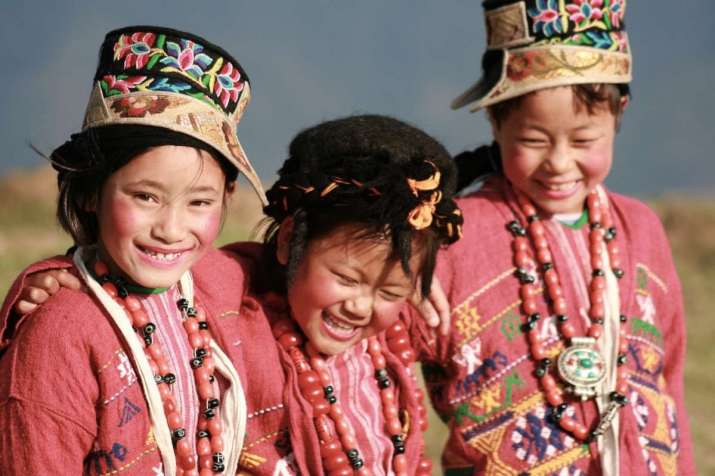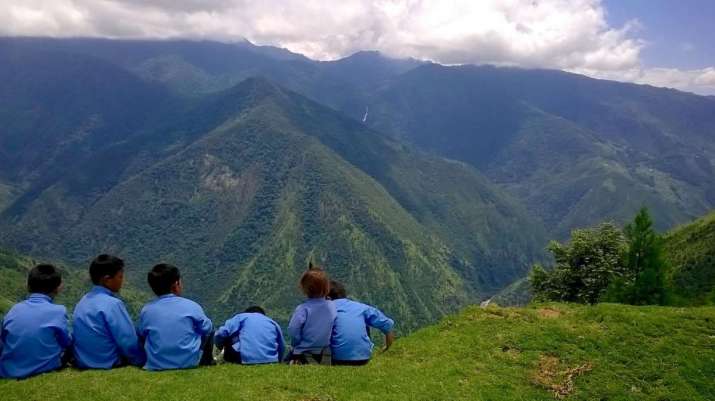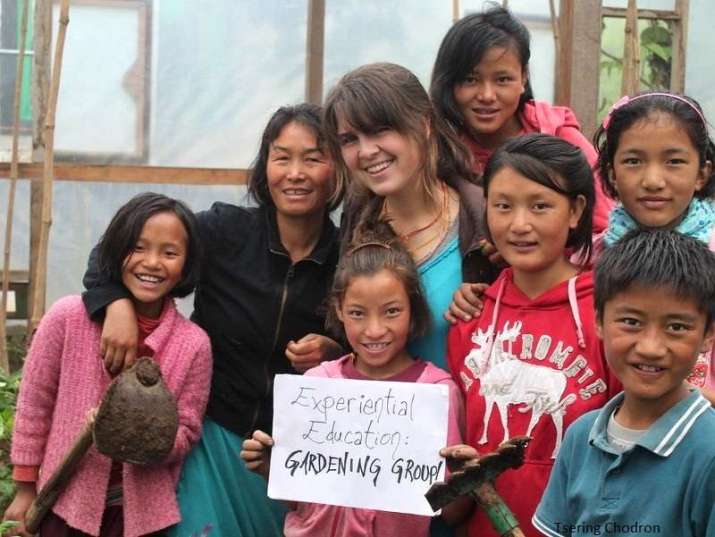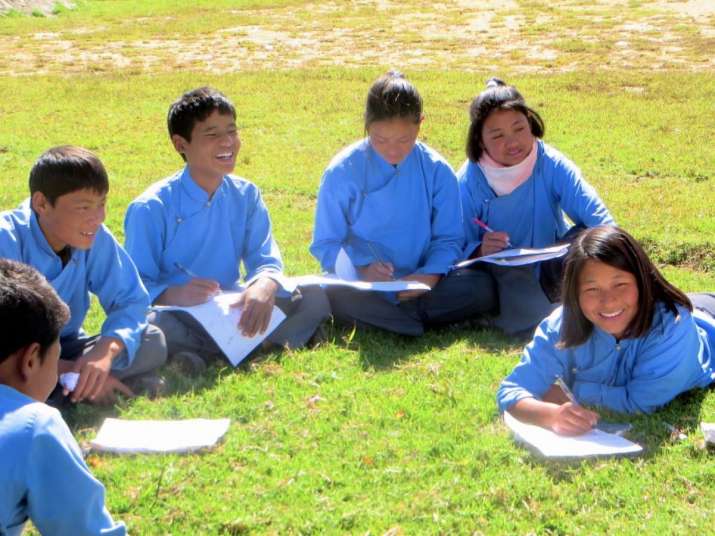FEATURES|COLUMNS|Buddhism in America (inactive)
Jhamtse Gatsal: Fostering Seeds of Compassion
 Children in traditional dress. Image courtesy of Jhamtse Gatsal
Children in traditional dress. Image courtesy of Jhamtse GatsalIn the late 1990s, Lobsang Phuntsok was one of 10 Buddhist monks selected by His Holiness the Dalai Lama to undertake a two-year training program in India specifically for monks that would then travel to the West to teach Buddhism. A teacher from the Gelugpa lineage of Tibetan Buddhism with exceptional language skills, Lobsang was invited by one of the rinpoches from Sera Jay Monastery in India in 2000 to translate for him during the UN Millennium Peace Conference in New York.
During his stay in New York, Lobsang decided to travel up to the Boston area to visit a friend from Sera Jay. Inspired to visit some local organizations there, he met a minister named Gloria Bates from a church in Brookline, who introduced him to the First Unitarian Church in Concord, Massachusetts. Lobsang was invited to give a talk at the chruch during one of the Sunday sermons, and the members were very moved. From this first talk, local seekers began to see the spark: “They wanted him to come back and give more teachings, and they conveyed to him how powerful his message of love and compassion was,” recalled Mark Foley, president of the US-based non-profit subsequently founded by Lobsang, Jhamste International.
The strong impression was mutual. Although Lobsang was in the US to translate at the UN, he knew that after the two-year training program, his mission was to return to teach Tibetan Buddhism. And so he began to think that Concord could be the place to put down roots and begin his sharing the Dharma. Lobsang went back to his monastery in India and spoke with his teachers, saying he believed he had found a place where he could teach. Given permission to do so, Lobsang returned and was hosted by a local community member.
And so Concord, Massachusetts, was blessed with a teacher who was able to guide them on a regular basis. From 2000–08, Lobsang brought the Buddhadharma to weekly teachings attended by 30–50 regular followers. The group grew strong, and the members took to Lobsang’s humility and warmth. Wanting opportunities to practice more intensely, Lobsang began to lead workshops and retreats in which the community could go deeper into their practice. During this period, the sangha continued to develop a sense of commitment and growth, and by the time Lobsang left Massachusetts in 2008, there were 300 sangha members.
“People wanted to be around his wisdom,” Mark observed. “And as a result of his impact, the sangha grew organically.”
 Children sit before a Himalayan vista at Jhamtse Gatsal. Image courtesy of Jhamtse Gatsal
Children sit before a Himalayan vista at Jhamtse Gatsal. Image courtesy of Jhamtse GatsalLobsang, however, did not limit his Dharma teaching to the sangha during those years. With a natural impulse to give succor to those who were suffering, he would visit local high schools and colleges, work with hospices, and train workers by giving Buddhist teachings. Living the Buddha’s teachings, he also worked with local adolescents who were experiencing anxiety.
“He worked with all kinds of people who really wanted to be exposed to his compassion,” said Mark. “All the teachings, visits, and workshops were based on that core foundation.”
Realizing how impactful his teachings were becoming, based on feedback from attendees, Lobsang understood he had made a strong connection with the community—strong enough that in 2003, he asked the local sangha to open a children’s community close to where he had grown up in Arunachal Pradesh, India’s most northeastern state, sharing borders with China, Bhutan, and Myanmar.
Responding to their teacher’s selfless request, a handful of members came together under his guidance. The response was immediate: “We said, absolutely, we will do whatever you need us to do.” Mark recollected. “So he talked about his vision for the children’s community in 2003, and in 2005 formed a local non-profit to realize his vision.”
They were able to open Jhamtse Gatsal Children’s Community in 2006, with a group of 35 children. Today, 88 children live at the community, with plans to grow further. What is strikingly evident about this manifestation of love nestled in the high Himalaya is that it is deliberately non-institutional, both in structure and spirit. Jhamtse Gatsal means “garden of love and compassion” in Tibetan. The sentiment expresses the wish to create a home where the children are seeds to be nurtured.
“We are modeled on a family,” said Jhamtse International’s executive director, Odessa Dwarika. “Whatever a family would provide and offer to their children is what the community will provide and offer the children who are there.”
Mark remembers one of Lobsang’s teachings at Lincoln Sudbury High School, where he talked about all human beings, especially young children, being the seeds of compassion. Lobsang says that from day one, “this is meant being a family and community environment that is supported largely through love and compassion. That is really the cornerstone of the community.”
For example, accommodation at Jhamtse Gatsal is all family-based: “Each family house has a name and it’s the name of a beautiful flower that grows in the Himalayas, Mark explained. “The women who care for the children are called ama-las, which essentially means ‘house mother.’ Everything is really intentional.”
 A gardening group at Jhamtse Gatsal. Image courtesy of Jhamtse Gatsal
A gardening group at Jhamtse Gatsal. Image courtesy of Jhamtse GatsalIn October and November 2013, Jhamste International invited filmmakers Andrew Hinton and Johnny Burke to make a documentary about their community. Together with a devoted production and post-production team, they put together a masterpiece, capturing the essence of the sanctuary. The film Tashi and the Monk, enjoyed worldwide exposure at film festivals and was shown on HBO and other venues. It also won an Emmy Award, allowing people internationally to have a real connection with Lobsang and Jhamste Gatsal. One could say that, geographically, Tashi and the Monk permitted the community to become an international one. That has enabled them to set higher goals.
“That number of people reaching out because of the film has really shifted what we can do as an organization,” Odessa noted. A current fundraising campaign is aimed at expanding the campus to serve up to 150 children and 50 adults. As the community grows, the housing will be kept small and family-based.
What the exceptional film conveys is that this is indeed an extended family. The older children look after the younger ones, supporting them and helping them adjust: “They feel it’s their responsibility to do so.” Odessa stated.
The children are educated holistically, in body, mind, and spirit. What is happening is nothing short of a miracle: in one of the most remote and under-resourced areas of India, children from tragic backgrounds are changed, transformed even. For example this year, 14 young adults will become graduating students, and the majority will go off to college, having achieved the 14 highest scores in their state on the national Indian college examinations.
“So these seeds of compassion have been planted deeply and now they are going to go off into the world, taking the next step of their journey, “ said Mark.
“We’re so excited about what is happening,” added Odessa.
Many want to become doctors and educators, and, not surprisingly, many of the graduates plan to return to the area to be of service. In this way, one could say the community practices a true philosophy of sustainable development that is having an impact on the entire region.
“This region is so remote that there is a necessity to be sustainable,” Odessa shared. Jhamtse Gatsal is a role model environmentally in its examples of energy consumption and food production, spreading practices throughout the state to encourage conservation. Certain technologies that would not have been available to the region are now coming in through Jhamtse Gatsal, through volunteers that come to install solar projects or introduce drip irrigation, for example. The intention is to share with local villages and communities.
Being a subculture within a culture, they are also committed to cultural preservation in the traditions of the Monpa tribe, one several of diverse ethic groups in the larger Tibetan community. “Part of the success of the children’s healing is that they are preserving a culture that is endangered,” Odessa remarked “Our work has aspects of cultural preservation and cultural celebration.”
Embodying their values, the children learn local cultural practices and, in turn, share this heritage, such as performing the Yak Dance at community celebrations in other parts of the region. In this way, Lobsang gives the children such a deep purpose.
Lobsang and the outstanding teachers and staff of Jhamste Gatsal are determined to engender long-term change in accordance with the core values upon which the community was founded. The children are primed to go out as leaders in the world, to become embodiments of the Dharma themselves. Odessa noted that the children would return to the community as professionals still committed to their culture.
“I don’t want to create children who can’t live in their Monpa villages,” Lobsang has said.
This notion follows the ethical principles of the community: “We want to raise very good human beings, not just really smart people.” Mark explained.
Odessa echoed this: “It’s great that we are raising them to go to college, but these are people who have learned how to put other people first.”
 Jhamtse Gatsal Children’s Community students. Image courtesy of Jhamtse Gatsal
Jhamtse Gatsal Children’s Community students. Image courtesy of Jhamtse GatsalAsked how the local sangha thinks of their teacher so far away, Mark observed that the sangha is constantly conscious of what they saw in, and heard from Lobsang when he was resident there: “He walked the talk,” he shared reflectively. “The children’s community is his most powerful teaching.”
Jhamtse Gatsal Children’s Community offers sponsorship and volunteer opportunities, as well as scholarships and endowment funds. A little over 20 years old, this remarkable community can serve as a model. Enrollment will be capped at 150 children in order to maintain the strong intentionality. Yet one could say the impact is just beginning to spread.
Back in Massachusetts, the group continues to meet and train their minds around the concepts of love and compassion. In Concord, there is a group that meets Wednesday mornings and another that meets Thursday evenings. There is also a group in nearby Worcester. The practitioners meet to meditate, study texts, and have discussions. It’s a vibrant community that keeps Lobsang’s presence vivid, continuing on the same trajectory.
It is clear that both the community in India and the community in Massachusetts have been transformed by the teachings of Buddhism. In fact, through their mutual practice of love and compassion and their supportive family environment, they are one sangha, one gem in the triple gem, co-fostering the seeds to serve the world beyond.
See more
Jhamste Gatsal Children’s Community
Jhamste International
Tashi and the Monk
Related features from Buddhistdoor Global
Filling the Emptiness with Love at the Duc Son Orphanage
Finding Ways to Educate Our Children with Buddhist Wisdom
Tsoknyi Gechak School: A Transformative and Holistic Learning Experience for Young Nuns
Related news from Buddhistdoor Global














